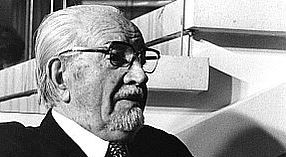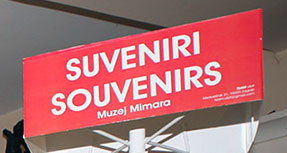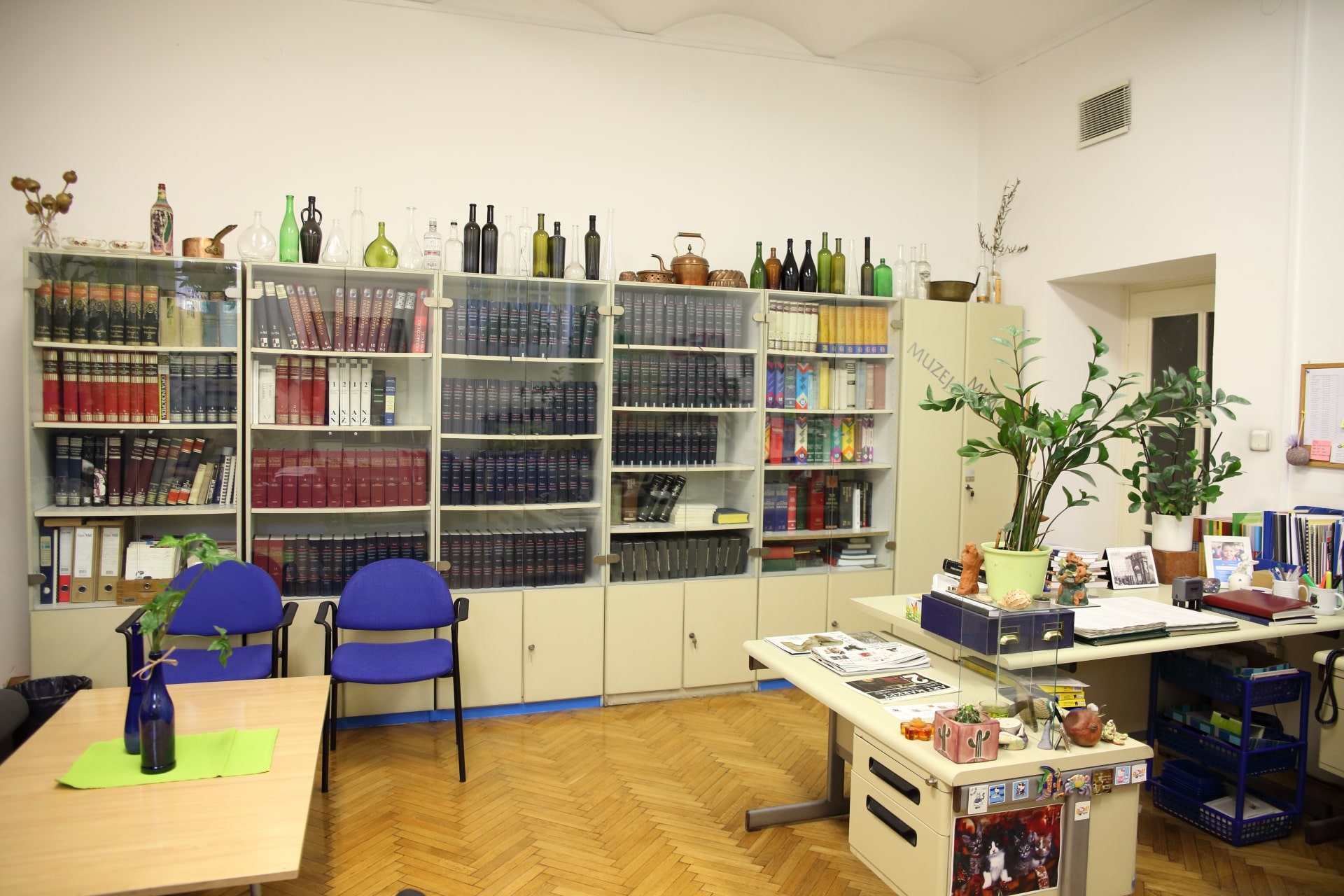23.09. - 31.12.2024.
Mythological characters from the European Sculpture Collection of the Mimara Museum
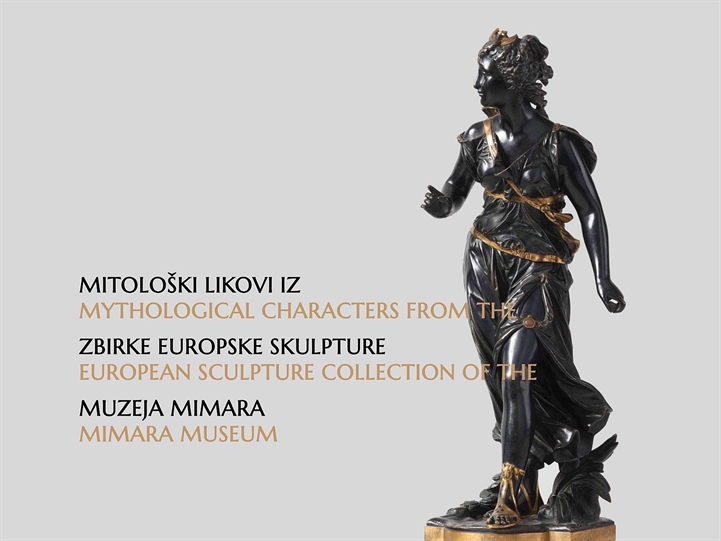
(Virtual) exhibitionMythological characters from the European Sculpture Collection of the Mimara Museum September 23, 2024 – December 31, 2024
***See exhibition (croatian version): Mitološki likovi iz Zbirke europske skulpture Muzeja Mimara***The European Sculpture Collection of the Mimara Museum is varied in terms of subject matter, materials and periods of creation. With this exhibition, we want to present the part of the collection that has in common that it has been inspired by ancient culture and myths. The sculptures presented were modeled after antiquity during the Renaissance, Mannerism and Neoclassical periods. They stand out for their quality and variety and are a very significant part of the Mimara Museum's Collection of European sculptures.Sculpture was the main art form in ancient Greece. The Greeks believed that their gods came in human shape, so the most important artistic expression was the depiction of the idealized human figure in sculptures dedicated to gods and heroes. After the conquest of Greece, the Romans took over Greek artistic principles, and one of the main purposes of Roman art was to glorify the emperors, emphasizing their power in sculptures, and embodying the ideal of beauty through the symmetry of proportions.The fall of Constantinople in 1453 led to the migration of Greek scholars, and thus the penetration of Greek culture into the West, which enabled its influence on artistic creativity and reflections on the ancient world. The fundamental concept of the Renaissance was the rebirth of science and art. Classical ideals of harmony, proportion and beauty were revived following the example of ancient art. Artists were inspired by Greek myths and classical themes, striving to surpass ancient models or to incorporate them into their works.As Protagoras said: "Man is the measure of all things", so the Renaissance artist considered the ideal measure to be the human form, which made humanism the most important movement of that time. By studying ancient manuscripts and developing a scientific and rational understanding of the world, humanists placed a free-spirited man at the center of the world, one who strives to question and acquire new knowledge.Interest in ancient art and Greek philosophy resulted in the vast representation of mythological and classical themes in art, mostly due to the enormous popularity of Greek dramas, tragedies and myths translated by Renaissance poets and writers. They adapted them to the currents of their time by adding Christian symbols and motifs that convey philosophical and moral themes, which is why showing the allegory of the victory of love over reason meant celebrating divine love.The sculptures that were made at that time depicted anatomically accurate and detailed bodies, with idealized proportions and accentuated muscles, emphasizing courage, strength and beauty. The human body was considered absolute sublimity, sculpture was freed from the architectural framework, depicted in contrapposto or naturalistic poses, most often cast in bronze or carved in stone and marble in full sculpture or relief.Renaissance humanists wanted not just to retell Greco-Roman myths, but also to devise new allegories that artists would bring to life visually. They tried to restore the old glory of Rome, which is why classical myths became popular among the educated population. Greek and Roman mythology represented to them something more than ordinary stories because they were convinced of the superior wisdom of ancient civilizations and believed that classical legends hide profound and mysterious truths. Farnese Hercules / Italy, 16th century / wood, 57,4 x 27,5 cm / ATM 1290Farnese Hercules is one of the most famous sculptures of antiquity. The Greek original was made in bronze by Lysippus in the 4th century BC. It was dissolved during the Sack of Constantinople in 1205. According to it, an enlarged marble copy was made in the 3rd century AD, which was found in Rome in 1546. It was called Farnese Hercules because the sculpture ended up in the collection of Cardinal Alessandro Farnese. Numerous graphics depicting Farnese Hercules contributed to his great popularity. Muscular Hercules is shown at rest, leaning on a club over which the skin of the Nemean Lion is hung. Hercules was tasked with serving Eurystheus, king of Mycenae, for 12 years, who required him to complete 12 tasks after which he would be rewarded with immortality. His first task was to kill the Nemean Lion whose skin he is always depicted with in works of art. The skin of the Nemean Lion was impenetrable and served as a shield against the weapons of other mortals, and the lion's claws could penetrate any armor. The sculpture of Farnese Hercules has significantly influenced artists with its impressive depiction of the hero's body in a moment of respite, symbolizing strength and perseverance of his heroic life.Greek and Roman art has always been a part of elite culture, and the aesthetics of that time tended towards mythological stories based on literary sources. Wealthy citizens ordered copies of popular ancient sculptures to exhibit in prominent places. The production of statues for the homes of the rich increased, and great importance was given to public sculptures in the historic centers of cities. Busts, portrait medals and relief plaques became popular. Also, small bronze figures were made, mostly for collectors' cabinets, with special emphasis on mythological themes. With the increase in the number of collectors, the production of smaller bronze sculptures also increased.
Farnese Hercules / Italy, 16th century / wood, 57,4 x 27,5 cm / ATM 1290Farnese Hercules is one of the most famous sculptures of antiquity. The Greek original was made in bronze by Lysippus in the 4th century BC. It was dissolved during the Sack of Constantinople in 1205. According to it, an enlarged marble copy was made in the 3rd century AD, which was found in Rome in 1546. It was called Farnese Hercules because the sculpture ended up in the collection of Cardinal Alessandro Farnese. Numerous graphics depicting Farnese Hercules contributed to his great popularity. Muscular Hercules is shown at rest, leaning on a club over which the skin of the Nemean Lion is hung. Hercules was tasked with serving Eurystheus, king of Mycenae, for 12 years, who required him to complete 12 tasks after which he would be rewarded with immortality. His first task was to kill the Nemean Lion whose skin he is always depicted with in works of art. The skin of the Nemean Lion was impenetrable and served as a shield against the weapons of other mortals, and the lion's claws could penetrate any armor. The sculpture of Farnese Hercules has significantly influenced artists with its impressive depiction of the hero's body in a moment of respite, symbolizing strength and perseverance of his heroic life.Greek and Roman art has always been a part of elite culture, and the aesthetics of that time tended towards mythological stories based on literary sources. Wealthy citizens ordered copies of popular ancient sculptures to exhibit in prominent places. The production of statues for the homes of the rich increased, and great importance was given to public sculptures in the historic centers of cities. Busts, portrait medals and relief plaques became popular. Also, small bronze figures were made, mostly for collectors' cabinets, with special emphasis on mythological themes. With the increase in the number of collectors, the production of smaller bronze sculptures also increased. Orpheus / Germany, 16th century / bronze, 27 x 12,2 cm / ATM 1226Orpheus was the son of the muse Calliope, the patroness of epic poetry. The famous poet, musician and prophet had the ability to charm all beings with his music, even stones. He joined the Argonauts to save them from the song of the sirens with his own music. Upon his return, he married Eurydice, who soon died after being bitten by a poisonous snake. His music moved the god of the underworld, Hades, so much so that he allowed Eurydice to return to the world of the living, but on the condition that Orpheus walk in front of her and not look back until they both reach the upper world. As soon as he arrived in the world of the living, Orpheus looked back to look at Eurydice while she was still in the world of the dead and thus disappeared forever. Orpheus is one of the most significant figures in the reception of classical mythology in Western culture.
Orpheus / Germany, 16th century / bronze, 27 x 12,2 cm / ATM 1226Orpheus was the son of the muse Calliope, the patroness of epic poetry. The famous poet, musician and prophet had the ability to charm all beings with his music, even stones. He joined the Argonauts to save them from the song of the sirens with his own music. Upon his return, he married Eurydice, who soon died after being bitten by a poisonous snake. His music moved the god of the underworld, Hades, so much so that he allowed Eurydice to return to the world of the living, but on the condition that Orpheus walk in front of her and not look back until they both reach the upper world. As soon as he arrived in the world of the living, Orpheus looked back to look at Eurydice while she was still in the world of the dead and thus disappeared forever. Orpheus is one of the most significant figures in the reception of classical mythology in Western culture.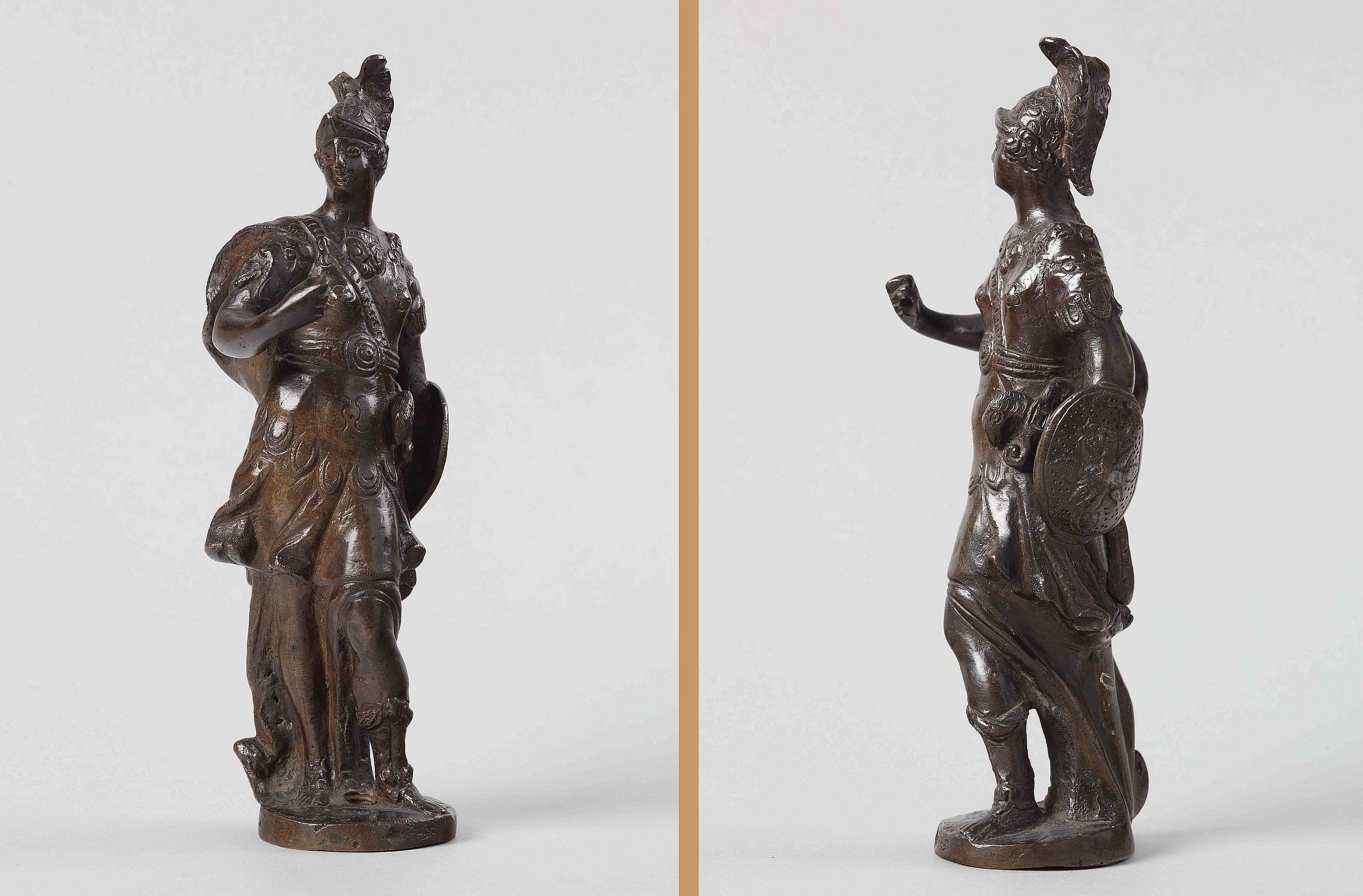 Athena Pallas / Italy, 16th century / bronze, 26 x 9,5 cm / ATM 2283Athena was the goddess of war, crafts and wisdom, patroness of the city of Athens, and her Roman counterpart was Minerva. She is shown in full armor, because according to legend she was born like this from the head of Zeus. She fought alongside Greek heroes and represented the skill and virtue of justice in warfare. She is depicted with an owl and a snake, as well as a helmet, a shield and a spear. Athena's epithet Pallas comes from Greek words meaning either to wave a weapon or a young woman, youth. Given that the original meaning of her epithet has been lost over the years, there are many myths and stories about the origin of the name Pallas.
Athena Pallas / Italy, 16th century / bronze, 26 x 9,5 cm / ATM 2283Athena was the goddess of war, crafts and wisdom, patroness of the city of Athens, and her Roman counterpart was Minerva. She is shown in full armor, because according to legend she was born like this from the head of Zeus. She fought alongside Greek heroes and represented the skill and virtue of justice in warfare. She is depicted with an owl and a snake, as well as a helmet, a shield and a spear. Athena's epithet Pallas comes from Greek words meaning either to wave a weapon or a young woman, youth. Given that the original meaning of her epithet has been lost over the years, there are many myths and stories about the origin of the name Pallas. Statuette of Mercury / Italy, 16th century / silver, 20,7 x 13,5 cm / ATM 2293Mercury (Greek name Hermes) is one of the 12 Dii Consentes (Harmonious Gods) – twelve main deities, six gods and six goddesses, in the pantheon of Ancient Rome. He is the Roman god of merchants, financial gain, abundance, travelers, luck, fraud and thieves. He also serves as a guide of souls to the underworld. He is most often depicted with a winged hat or winged sandals and holding a caduceus in his left hand (a staff entwined with two snakes, surmounted by wings symbolizing intelligence). Mercury from the Mimara Museum is shown with a cornucopia in his right hand (cornucopia - in classical antiquity, the cornucopia was a symbol of abundance and food). A large basket horn, which he holds in his right hand, is full of fruits, flowers and nuts. On his head is a hat with wings, and in his left hand he once held a caduceus.
Statuette of Mercury / Italy, 16th century / silver, 20,7 x 13,5 cm / ATM 2293Mercury (Greek name Hermes) is one of the 12 Dii Consentes (Harmonious Gods) – twelve main deities, six gods and six goddesses, in the pantheon of Ancient Rome. He is the Roman god of merchants, financial gain, abundance, travelers, luck, fraud and thieves. He also serves as a guide of souls to the underworld. He is most often depicted with a winged hat or winged sandals and holding a caduceus in his left hand (a staff entwined with two snakes, surmounted by wings symbolizing intelligence). Mercury from the Mimara Museum is shown with a cornucopia in his right hand (cornucopia - in classical antiquity, the cornucopia was a symbol of abundance and food). A large basket horn, which he holds in his right hand, is full of fruits, flowers and nuts. On his head is a hat with wings, and in his left hand he once held a caduceus. Mercury / Germany, 16th century / marble, 27,5 x 10,7 cm / ATM 1230The sculpture of Mercury from the Mimara Museum is made of marble with gilding. He is shown leaning lightly on a tree stump, wearing a cap with wings on his head, and probably holding a bag in his left hand as a symbol of merchants, abundance and financial gain. Mercury became especially popular among the peoples conquered by the Roman Empire. The Romans associated him with the Germanic god Wodan (South German name, while the more famous North German name is Odin), whom the Roman historian Tacitus identified as the main god of the Germanic peoples. In Romance languages, Wednesday is named after Mercury (Italian mercoledì, French mercredi, Spanish miércoles, Romanian miercuri), and after the Germanic god Wodan, who is equated with Mercury, the name for Wednesday is used in English and Swedish (English Wednesday, Swedish onsdag).
Mercury / Germany, 16th century / marble, 27,5 x 10,7 cm / ATM 1230The sculpture of Mercury from the Mimara Museum is made of marble with gilding. He is shown leaning lightly on a tree stump, wearing a cap with wings on his head, and probably holding a bag in his left hand as a symbol of merchants, abundance and financial gain. Mercury became especially popular among the peoples conquered by the Roman Empire. The Romans associated him with the Germanic god Wodan (South German name, while the more famous North German name is Odin), whom the Roman historian Tacitus identified as the main god of the Germanic peoples. In Romance languages, Wednesday is named after Mercury (Italian mercoledì, French mercredi, Spanish miércoles, Romanian miercuri), and after the Germanic god Wodan, who is equated with Mercury, the name for Wednesday is used in English and Swedish (English Wednesday, Swedish onsdag). Mercury / Italy, 16th century / bronze, 17,4 x 5,3 cm / ATM 1218In Greek mythology, Mercury is the son of the nymph Maia (one of the seven Pleiades, daughter of the Titan Atlas) and Zeus. His Roman name Mercurius comes from the Latin word for merchandise, merx or mercator, meaning merchant. The theme of the flying Mercury spread throughout Europe, conveying the Mannerist style. Mercury rising and standing on one leg, as depicted in Giambologna's* sculpture Flying Mercury, became the model for numerous later depictions of this deity.* pseudonym of Jean De Boulogne, a Flemish sculptor who worked in Italy and became the most important Mannerist sculptor in Florence
Mercury / Italy, 16th century / bronze, 17,4 x 5,3 cm / ATM 1218In Greek mythology, Mercury is the son of the nymph Maia (one of the seven Pleiades, daughter of the Titan Atlas) and Zeus. His Roman name Mercurius comes from the Latin word for merchandise, merx or mercator, meaning merchant. The theme of the flying Mercury spread throughout Europe, conveying the Mannerist style. Mercury rising and standing on one leg, as depicted in Giambologna's* sculpture Flying Mercury, became the model for numerous later depictions of this deity.* pseudonym of Jean De Boulogne, a Flemish sculptor who worked in Italy and became the most important Mannerist sculptor in Florence Plaque depicting the Abduction of the Sabine women / Germany, 17th century / bronze, Ø 15,6 cm / ATM 2337The plaque in shallow relief shows in detail a scene from a classical legend in which the founders of the city of Rome, during a festival organized by Romulus, abducted the Sabine women, residents of the surrounding areas, in order to ensure an increase in the city's population. Later, the king of the Sabines, Titus Tatius, declared war on Rome because of their abduction, and the Sabine women who were already married to Roman men, in order to prevent the massacre, begged their fathers and countrymen to stop fighting against their husbands. They prevented further fighting and achieved partnership and peace between the two tribes.After the playful and dynamic styles of Baroque and Rococo, as a direct reaction to them, a movement called Neoclassicism appeared. The society of that time, after a period full of decorations with an abundance of ornaments, theatricality, curves and undulations, longed for the simplicity, purity, symmetry and idealism of ancient Greece and Rome.In the presentation of sculptures, artists turned to the model of classical antiquity and left the decorativeness of previous periods far behind, thus becoming an inspiration for future generations of sculptors.
Plaque depicting the Abduction of the Sabine women / Germany, 17th century / bronze, Ø 15,6 cm / ATM 2337The plaque in shallow relief shows in detail a scene from a classical legend in which the founders of the city of Rome, during a festival organized by Romulus, abducted the Sabine women, residents of the surrounding areas, in order to ensure an increase in the city's population. Later, the king of the Sabines, Titus Tatius, declared war on Rome because of their abduction, and the Sabine women who were already married to Roman men, in order to prevent the massacre, begged their fathers and countrymen to stop fighting against their husbands. They prevented further fighting and achieved partnership and peace between the two tribes.After the playful and dynamic styles of Baroque and Rococo, as a direct reaction to them, a movement called Neoclassicism appeared. The society of that time, after a period full of decorations with an abundance of ornaments, theatricality, curves and undulations, longed for the simplicity, purity, symmetry and idealism of ancient Greece and Rome.In the presentation of sculptures, artists turned to the model of classical antiquity and left the decorativeness of previous periods far behind, thus becoming an inspiration for future generations of sculptors.  The Judgement of Paris / Italy, 18th century / bronze, Ø 19,3 cm / ATM 2286The Judgment of Paris is an event from Greek mythology that led to the Trojan War. Since Eris, the goddess of discord, was not invited to the wedding of Peleus and Thetis, she decided to throw a golden apple with the inscription "to the fairest one" among the guests. The goddesses Hera, Athena and Aphrodite argued about who should get the apple, so it was agreed that Paris, the son of the Trojan king Priam, would decide who is the most beautiful one and give her the apple. He chose Aphrodite, who bribed him with the most beautiful woman in the world, Helen, the wife of the Spartan king Menelaus. In order to return Helen, who was taken by Paris to Troy, the Greeks attacked the Trojans, which marked the start of the Trojan War.Three key events contributed to a renewed interest in ancient art: archaeological research such as the discovery of Herculaneum (in 1738) and the excavation of Pompeii; Great European travels during which the young rich visited Italy and Greece in search of culture and art; and the writings of Johann Joachim Winckelmann, a German philosopher and archaeologist, whose ideas fueled the rise of neoclassicism and the influence of Greek and Roman art.Wealthy citizens brought back souvenirs from their travels, and archeology became a popular scientific field. Illustrations and excavation reports spread across Europe, fueling a new interest in classical antiquities. The passion for the past was revived and the interest in the ideal symmetry, harmony, simplicity and proportions of the ancient era returned. The artists' focus was on simple forms, myths were a source of inspiration, and the heroism and exploits of mythical protagonists were most often depicted, which was particularly visible in historical scenes and depictions of battles. Numerous successful archaeological excavations contributed to the rapid growth of collections of ancient sculptures which spread across Europe due to the growing number of collectors and the desire of citizens to decorate private houses with copies of Greek and Roman originals.A frequent theme was love associated with depictions of celebrations or parties, personified by the figure of Venus (Aphrodite), along with Psyche, Bacchus, and a multitude of Cupids dancing, celebrating and having fun drinking wine. Cupid was depicted as a smiling child, inspired by the Greek god of love Eros, often shown in scenes of seduction or love woes.
The Judgement of Paris / Italy, 18th century / bronze, Ø 19,3 cm / ATM 2286The Judgment of Paris is an event from Greek mythology that led to the Trojan War. Since Eris, the goddess of discord, was not invited to the wedding of Peleus and Thetis, she decided to throw a golden apple with the inscription "to the fairest one" among the guests. The goddesses Hera, Athena and Aphrodite argued about who should get the apple, so it was agreed that Paris, the son of the Trojan king Priam, would decide who is the most beautiful one and give her the apple. He chose Aphrodite, who bribed him with the most beautiful woman in the world, Helen, the wife of the Spartan king Menelaus. In order to return Helen, who was taken by Paris to Troy, the Greeks attacked the Trojans, which marked the start of the Trojan War.Three key events contributed to a renewed interest in ancient art: archaeological research such as the discovery of Herculaneum (in 1738) and the excavation of Pompeii; Great European travels during which the young rich visited Italy and Greece in search of culture and art; and the writings of Johann Joachim Winckelmann, a German philosopher and archaeologist, whose ideas fueled the rise of neoclassicism and the influence of Greek and Roman art.Wealthy citizens brought back souvenirs from their travels, and archeology became a popular scientific field. Illustrations and excavation reports spread across Europe, fueling a new interest in classical antiquities. The passion for the past was revived and the interest in the ideal symmetry, harmony, simplicity and proportions of the ancient era returned. The artists' focus was on simple forms, myths were a source of inspiration, and the heroism and exploits of mythical protagonists were most often depicted, which was particularly visible in historical scenes and depictions of battles. Numerous successful archaeological excavations contributed to the rapid growth of collections of ancient sculptures which spread across Europe due to the growing number of collectors and the desire of citizens to decorate private houses with copies of Greek and Roman originals.A frequent theme was love associated with depictions of celebrations or parties, personified by the figure of Venus (Aphrodite), along with Psyche, Bacchus, and a multitude of Cupids dancing, celebrating and having fun drinking wine. Cupid was depicted as a smiling child, inspired by the Greek god of love Eros, often shown in scenes of seduction or love woes.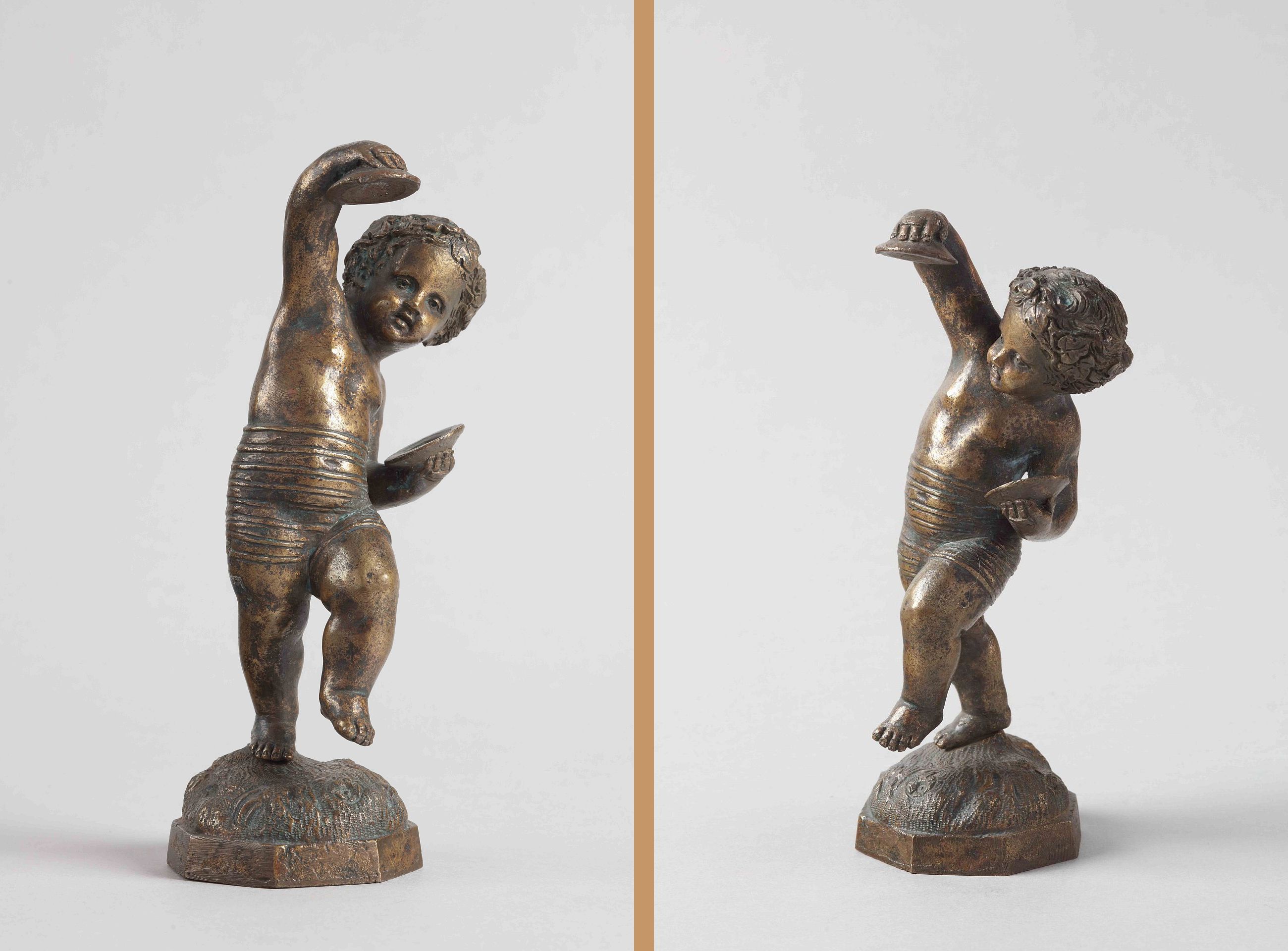 Small Putto with Percussion and Laurel Wreath / Italy, 18th century / bronze, 19 x 7 cm / ATM 2287Putto is a small chubby boy depicted as a counterpart to Cupid (Amor) or the Greek god Eros, and later coming to represent a kind of angel in sacred art, often depicted with wings (cherub).The figure of putto begins to appear during the Renaissance, and has its roots in classical mythology. The earliest motifs of putto are shown on children's sarcophagi, most often in dancing and rejoicing. During the Renaissance, it was realized in different ways, and in later periods, we find its flourishing in works of art in the 19th century.In the Dionysian depictions, joy never grows into exuberance, but is kept under control, as the gestures of neoclassical sculptures are restrained in order to emphasize spiritual nobility and beauty. The sculptures most often depicted nudes or characters in typical Greek clothing from the Antiquity era. The themes were heroic and expressed in an ancient way, but with a mixture of themes from the life of that time and modern literature. Favorite mythological themes included depictions of goddesses and gods (Athena, Diana, Heracles, Mercury, Dionysus) and heroes of Greek myths (protagonists of the Trojan War, the Iliad and the Odyssey).
Small Putto with Percussion and Laurel Wreath / Italy, 18th century / bronze, 19 x 7 cm / ATM 2287Putto is a small chubby boy depicted as a counterpart to Cupid (Amor) or the Greek god Eros, and later coming to represent a kind of angel in sacred art, often depicted with wings (cherub).The figure of putto begins to appear during the Renaissance, and has its roots in classical mythology. The earliest motifs of putto are shown on children's sarcophagi, most often in dancing and rejoicing. During the Renaissance, it was realized in different ways, and in later periods, we find its flourishing in works of art in the 19th century.In the Dionysian depictions, joy never grows into exuberance, but is kept under control, as the gestures of neoclassical sculptures are restrained in order to emphasize spiritual nobility and beauty. The sculptures most often depicted nudes or characters in typical Greek clothing from the Antiquity era. The themes were heroic and expressed in an ancient way, but with a mixture of themes from the life of that time and modern literature. Favorite mythological themes included depictions of goddesses and gods (Athena, Diana, Heracles, Mercury, Dionysus) and heroes of Greek myths (protagonists of the Trojan War, the Iliad and the Odyssey). Mythological Scene with Dionysian Festivities / France, 18th century / bronze, 57 x 21 cm / ATM 2303Dionysus is the Greek god of fertility who became known in later art as the god of wine, pleasure and festivities. His Roman counterpart is Bacchus. He is known for excessive drinking and debauchery, from which the word Bacchanalia was born. At first he was depicted as an elderly man with a beard, and later as a young man with a wreath of vines or grapes.Dionysian festivities included the performance of plays and songs and an all-night party with dancing and wine, during which people could be unrestrained, merry, drink and dance, and be liberated from all social conventions, in honor and glory of Dionysus.Hellenistic sculpture (the last period of Greek sculpture) had a significant influence on the sculpture of the 19th century, which was distinguished by the improvement of human anatomy, the development of new techniques, the emphasis on the purely aesthetic and the reinforcement of the dramatic. The ruling class of the 19th century expressed its social and business success with the decorative elements of its household. Later, the models of Greece and Rome were ubiquitous, and mythological characters were depicted not only on free-standing sculptures and reliefs, but also as decorative elements of clocks, chests, porcelain services, and candlesticks. Such decoration of objects for the upper class was proof of good taste and the dominant trend until the end of the 19th century. Due to the high market demand, copies of ancient works of various sizes began to be made, which were extremely important for the spread of knowledge about antiquity in the late 18th and early 19th centuries. The originals disappeared over time and only copies made during that period remain. The new neoclassical style provided an aesthetic consensus for the bourgeoisie whose ambition was to become the dominant social class.
Mythological Scene with Dionysian Festivities / France, 18th century / bronze, 57 x 21 cm / ATM 2303Dionysus is the Greek god of fertility who became known in later art as the god of wine, pleasure and festivities. His Roman counterpart is Bacchus. He is known for excessive drinking and debauchery, from which the word Bacchanalia was born. At first he was depicted as an elderly man with a beard, and later as a young man with a wreath of vines or grapes.Dionysian festivities included the performance of plays and songs and an all-night party with dancing and wine, during which people could be unrestrained, merry, drink and dance, and be liberated from all social conventions, in honor and glory of Dionysus.Hellenistic sculpture (the last period of Greek sculpture) had a significant influence on the sculpture of the 19th century, which was distinguished by the improvement of human anatomy, the development of new techniques, the emphasis on the purely aesthetic and the reinforcement of the dramatic. The ruling class of the 19th century expressed its social and business success with the decorative elements of its household. Later, the models of Greece and Rome were ubiquitous, and mythological characters were depicted not only on free-standing sculptures and reliefs, but also as decorative elements of clocks, chests, porcelain services, and candlesticks. Such decoration of objects for the upper class was proof of good taste and the dominant trend until the end of the 19th century. Due to the high market demand, copies of ancient works of various sizes began to be made, which were extremely important for the spread of knowledge about antiquity in the late 18th and early 19th centuries. The originals disappeared over time and only copies made during that period remain. The new neoclassical style provided an aesthetic consensus for the bourgeoisie whose ambition was to become the dominant social class.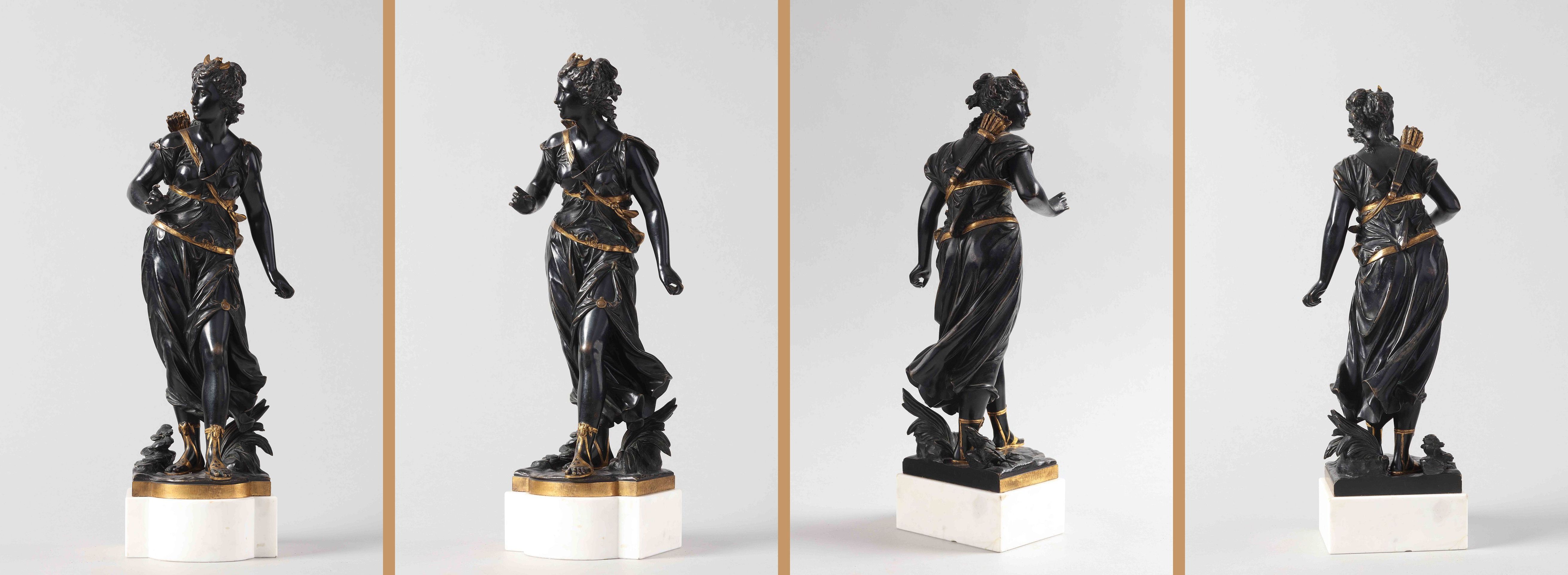 Diana / France, 19th century / bronze, 37,1 x 14,8 cm / ATM 1214Diana is the Roman goddess of hunters, wild animals and nature. Her counterpart is the Greek goddess Artemis. She was considered a triple deity (Diana triformis), united with the underworld goddess Hecate and the moon goddess Luna. As the goddess of hunting, Diana is often depicted with a bow and arrow.The art of neoclassicism is associated with the Enlightenment period because it often emphasizes the themes of patriotism, morality, individual struggle and state power. Public figures were depicted as Greek and Roman gods. High reliefs modeled on Greek temple reliefs were made. Most artists of the 18th and 19th centuries went on trips to Italy, especially to Rome, and studied ancient works and the works of the great Renaissance masters. Under the influence of these periods, they began to create sculptures of the same themes and motifs, most often heroic themes, mythological characters and allegories which remained a permanent inspiration of the artists. Expressive depictions of love were also drawn from Greek mythology. The influences of ancient mythology are also visible on monumental sculptures with romanticized depictions of Victoria (that is, Nike), Roman and Greek goddess, the personification of victory.Large public annual exhibitions influenced the importance of sculptures and their demand. The organization of exhibitions was taken over by artists, and patrons and nobility continued to play an important role in the popularity of certain sculptors.Plaster casts of the original clay models were shown at exhibitions, and marble or bronze sculptures were made to order, mostly for collectors who would place these sculptures in their gardens, greenhouses or living rooms. Later, sculptures began to be shown with classical lines and romanticist feelings.
Diana / France, 19th century / bronze, 37,1 x 14,8 cm / ATM 1214Diana is the Roman goddess of hunters, wild animals and nature. Her counterpart is the Greek goddess Artemis. She was considered a triple deity (Diana triformis), united with the underworld goddess Hecate and the moon goddess Luna. As the goddess of hunting, Diana is often depicted with a bow and arrow.The art of neoclassicism is associated with the Enlightenment period because it often emphasizes the themes of patriotism, morality, individual struggle and state power. Public figures were depicted as Greek and Roman gods. High reliefs modeled on Greek temple reliefs were made. Most artists of the 18th and 19th centuries went on trips to Italy, especially to Rome, and studied ancient works and the works of the great Renaissance masters. Under the influence of these periods, they began to create sculptures of the same themes and motifs, most often heroic themes, mythological characters and allegories which remained a permanent inspiration of the artists. Expressive depictions of love were also drawn from Greek mythology. The influences of ancient mythology are also visible on monumental sculptures with romanticized depictions of Victoria (that is, Nike), Roman and Greek goddess, the personification of victory.Large public annual exhibitions influenced the importance of sculptures and their demand. The organization of exhibitions was taken over by artists, and patrons and nobility continued to play an important role in the popularity of certain sculptors.Plaster casts of the original clay models were shown at exhibitions, and marble or bronze sculptures were made to order, mostly for collectors who would place these sculptures in their gardens, greenhouses or living rooms. Later, sculptures began to be shown with classical lines and romanticist feelings. Family of satires / France, 19th century / terracotta, Ø 41 cm / ATM 2304A satyr, or faun, is a mythological being depicted as a man with the legs and tail of a goat, horns and pointed ears. Its appearance is taken from the god Pan, and it symbolizes peace and fertility. The relief shows a family of satyrs in the forest, where the father satyr playing the flute is sitting on a swing on one side, and the mother satyr is sitting on the other side. Among them are two small playful satyr children.
Family of satires / France, 19th century / terracotta, Ø 41 cm / ATM 2304A satyr, or faun, is a mythological being depicted as a man with the legs and tail of a goat, horns and pointed ears. Its appearance is taken from the god Pan, and it symbolizes peace and fertility. The relief shows a family of satyrs in the forest, where the father satyr playing the flute is sitting on a swing on one side, and the mother satyr is sitting on the other side. Among them are two small playful satyr children.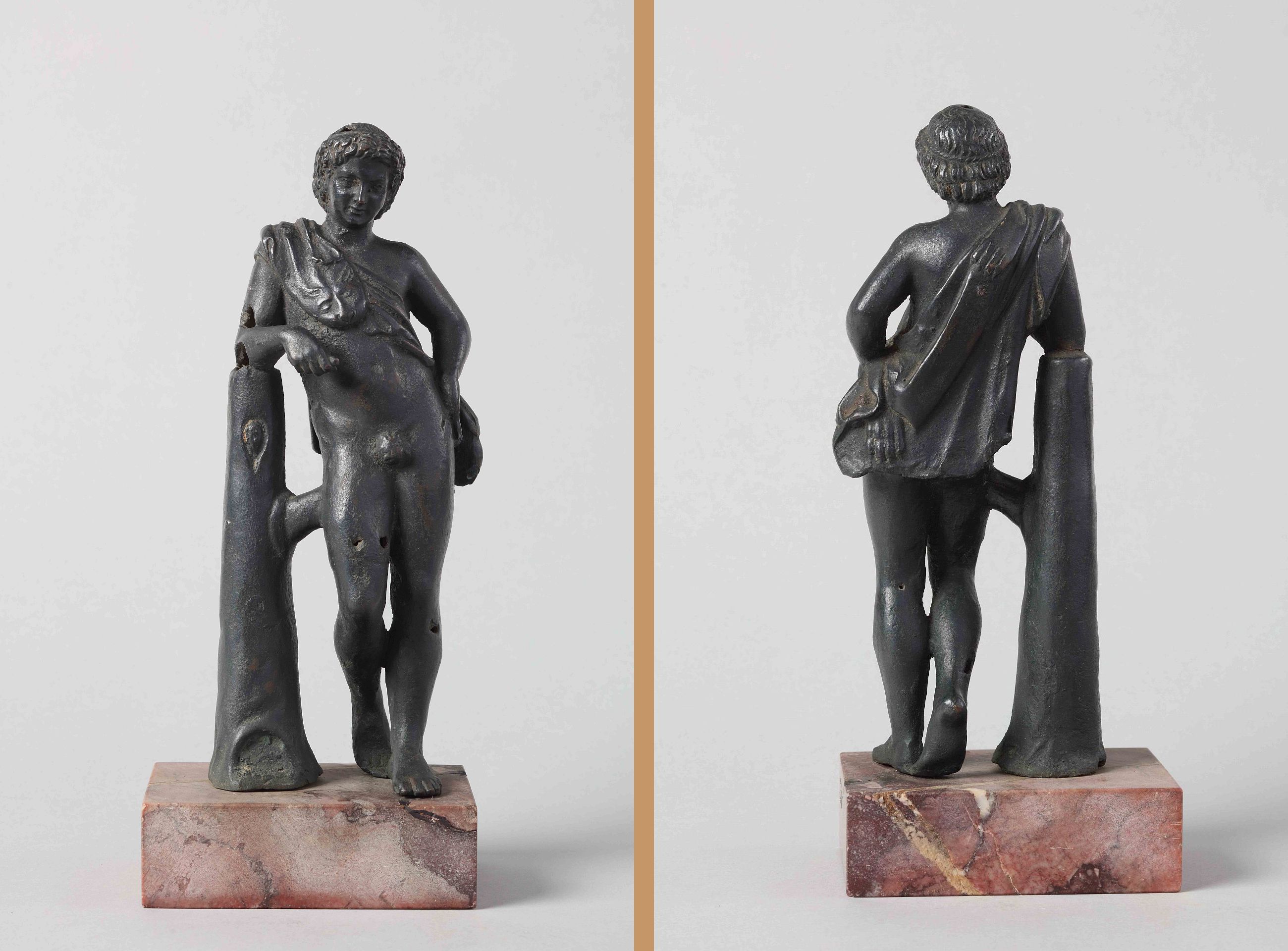 Resting satyr / Italy, 19th century / bronze, 25 x 10,3 cm / ATM 1220This depiction of a resting satyr is known as a Satyr anapaumenos attributed to the ancient Greek sculptor Praxiteles. Numerous copies of this type of satyr are known, which show him as a young man leaning his right elbow on a tree trunk while holding a flute in his hand, and resting his left hand on his side. A panther skin is draped over his torso.The satyr is a companion of the god Dionysus, and is known for his love of wine, women and playing the flute. In art, he is most often depicted with a flute or pipes in hand.The newly created sculptures, which are based on Greek and Roman mythology, place the context of mythological themes in recent times where contemporary characters become the actors in the story. Sensationalism and emphasis on feelings is encouraged. Technical innovations made it possible to easily reproduce exhibition pieces and different reproductions of bronze sculptures. The popularity of small sculptures grew and there was a boom in portrait statues, most often made in bronze.
Resting satyr / Italy, 19th century / bronze, 25 x 10,3 cm / ATM 1220This depiction of a resting satyr is known as a Satyr anapaumenos attributed to the ancient Greek sculptor Praxiteles. Numerous copies of this type of satyr are known, which show him as a young man leaning his right elbow on a tree trunk while holding a flute in his hand, and resting his left hand on his side. A panther skin is draped over his torso.The satyr is a companion of the god Dionysus, and is known for his love of wine, women and playing the flute. In art, he is most often depicted with a flute or pipes in hand.The newly created sculptures, which are based on Greek and Roman mythology, place the context of mythological themes in recent times where contemporary characters become the actors in the story. Sensationalism and emphasis on feelings is encouraged. Technical innovations made it possible to easily reproduce exhibition pieces and different reproductions of bronze sculptures. The popularity of small sculptures grew and there was a boom in portrait statues, most often made in bronze.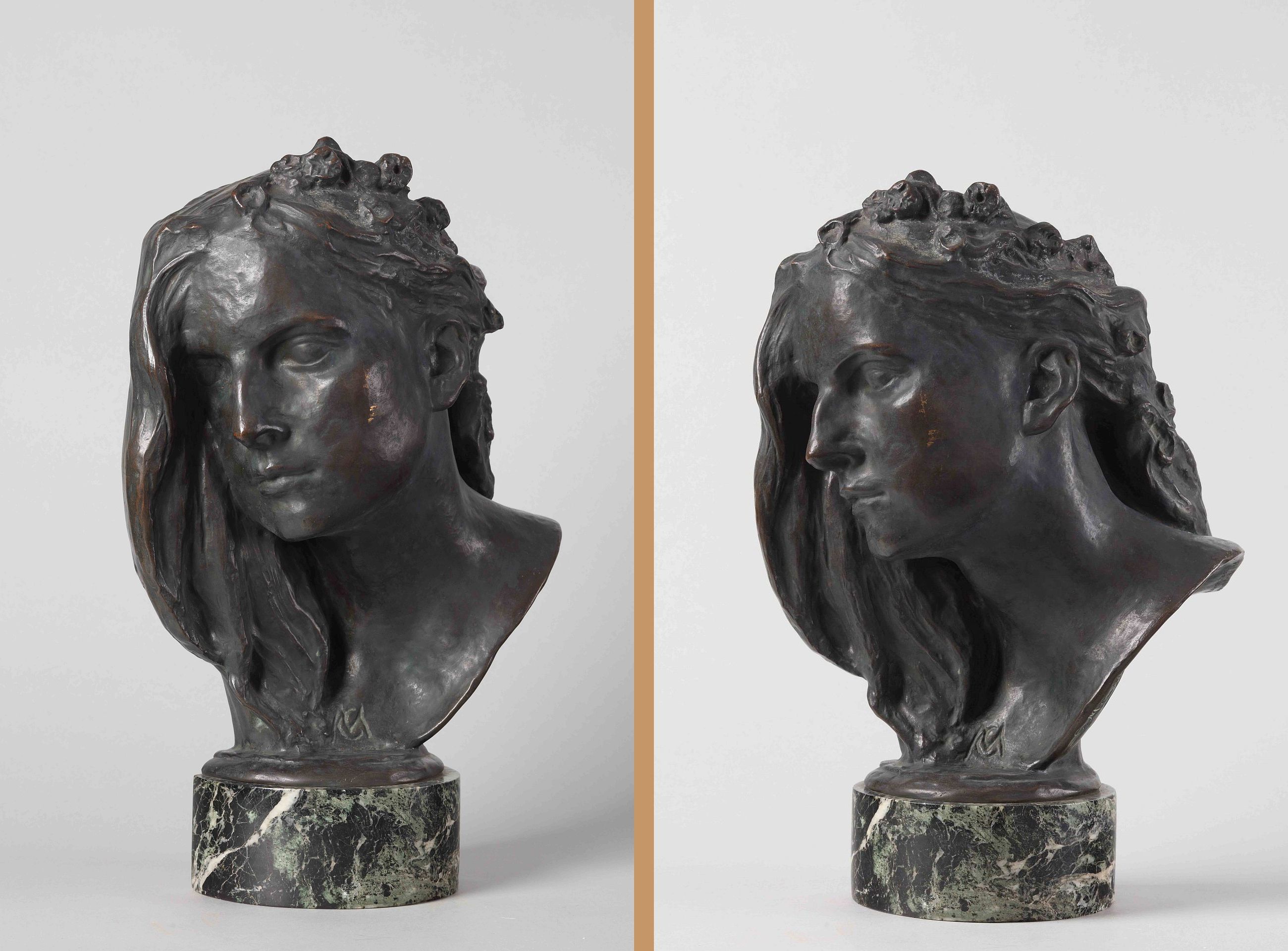 Head of Flora / Belgium, late 19th century / bronze, 36,2 x 28,3 cm / ATM 1313Flora is the Roman goddess of flowers and spring. She originates from Greek mythology where she is known as Kloris, the goddess of flowers, spring and nymphs. Flora was one of the few goddesses who had her own festivals, the Floralia, which were honored as expression of gratitude for excellent crops, vegetation, flowers and fertility. She is often depicted with flowers in loose hair.Later sculpture abandons the academic tradition and moves towards naturalistic depictions and explores literary and mythological themes. Sculpture as a means of expression becomes the basis of modern creativity, continuing to depict mythological motifs, new symbols, allegories and modernized ancient depictions.Throughout history, mythological figures and stories from ancient Greece and Rome have remained a constant source of inspiration in sculpture. From Classical Greece, through Renaissance Italy, to Neoclassicism and beyond, these themes not only shaped artistic expressions, but also reflected the cultural and intellectual currents of each era.
Head of Flora / Belgium, late 19th century / bronze, 36,2 x 28,3 cm / ATM 1313Flora is the Roman goddess of flowers and spring. She originates from Greek mythology where she is known as Kloris, the goddess of flowers, spring and nymphs. Flora was one of the few goddesses who had her own festivals, the Floralia, which were honored as expression of gratitude for excellent crops, vegetation, flowers and fertility. She is often depicted with flowers in loose hair.Later sculpture abandons the academic tradition and moves towards naturalistic depictions and explores literary and mythological themes. Sculpture as a means of expression becomes the basis of modern creativity, continuing to depict mythological motifs, new symbols, allegories and modernized ancient depictions.Throughout history, mythological figures and stories from ancient Greece and Rome have remained a constant source of inspiration in sculpture. From Classical Greece, through Renaissance Italy, to Neoclassicism and beyond, these themes not only shaped artistic expressions, but also reflected the cultural and intellectual currents of each era.Exhibition author: Andrea Birač




